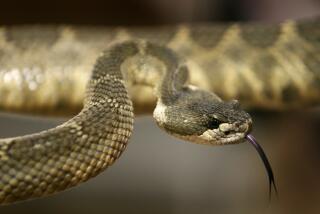Students Learn to Tread Lightly Amid Rattlers
- Share via
BREA — This week’s score: Brea-Olinda Wildcats 4, Pacific Rattlesnakes 0.
Recent weeks of warm weather have stirred rattlesnakes from their winter hiding places and into losing confrontations with humans at the new Brea-Olinda High School, which opened last September in the undeveloped foothills of north Brea.
Groundskeepers and athletic coaches have killed about 30 rattlesnakes since the school year began, most of them in the last few weeks. Just after the warm weather started, four rattlers were killed during one afternoon’s track practice, said varsity football Coach Jon Looney
“We use the closest weapon we can find,” he said. “When we found one snake out by the track, I couldn’t find a rock so I picked up a (12-pound) shot put and drilled him with it.”
The black Pacific rattler, native to the foothills of North County, has confined itself mostly to areas off the beaten path of the campus. But one was recently discovered slithering across the school’s quadrangle area that leads to most of the classrooms.
By building into the hillside, people are slowly degrading the natural habitat of the rattlers and other native animals, said Bayard Brattstrom, a professor of zoology at Cal State Fullerton. Pacific rattlesnakes are still numerous and not in danger of extinction, he said.
As activity increases at the high school and the snakes living around the school are killed, snake sightings should taper off, Brattstrom said. Spring and fall are the most active times for snakes, he said.
“The snake leaves its hole, wanders around where it did last year and suddenly finds itself in a parking lot,” Brattstrom said. “It gets scared and hides in a bush or something.”
No one has been bitten and the snakes are not considered a major threat, Co-Principal Gary Goff said Friday. But students and staff have been warned of the potential danger and are told to watch where they walk, he said.
“It’s not a big deal. We don’t walk around with our snake boots on,” Goff said. “But it’s made for good conversation.”
Sharing a hillside with venomous snakes doesn’t seem to be a problem for most students and teachers at the high school.
“The good thing about snakes is if you don’t bother them, they won’t bother you,” Spanish teacher Donna Burgard said.
“It’s not like it’s a big deal,” said Naazneen Somji, 15. “The thing on campus people are talking about is the campaign (for class officers). The snakes were here before us so it doesn’t bother me--unless I see one.”
Sarah Jones, 16, saw one outside her history classroom when district groundskeepers, pulling weeds from a slope outside a classroom building, stirred up a rattler that slithered into the parking lot.
“They chopped its head off,” Jones said. “It was really gross.”
One of the grounds workers, who killed three of the snakes last week, takes the bodies home for dinner and is making a hatband from the rattlers’ skin, said Curt Bjork, the district’s lead groundsman.
About a month ago, students spotted one rattler on the slope next to the track, and the coaches decided to get rid of it rather than risk having the snake come onto the field, Perrance said.
As he and Looney approached the snake, it coiled up and eyed the men warily.
“It was hissing and spitting and rattling like a baby rattle gone wild,” Perrance said. “It was real ugly and mean. At the time, it looked like it was about 20 feet long but it turned out to be about four feet. It was one ticked-off dude.”
In an attempt to flee, the snake bolted in the direction of the coaches.
“That’s the fastest I’ve moved in a long time,” Looney said.
Trying to kill a snake is how most people are bitten, Brattstrom said. The safest approach for people accidentally stumbling upon a rattlesnake is to stop and slowly back away, he said.
The Pacific rattler common to the Brea hills and Carbon Canyon area is not highly poisonous, he said, but all rattlesnake bites should be taken seriously. Still, more people die from beestings than from snakebites in the United States, he noted.
If a person is bitten, the best thing to do is sit down and relax while somebody calls the paramedics. “If you do that, your chances of surviving are 95%,” Brattstrom said.
Panicking or running around causes the blood to circulate the venom faster, and more people die from shock after a snake bite than from the venom, he said.
“The important thing to explain to people is it’s a matter of us invading their property,” he said. “We’ll see them for a year or two and people should be cautious.”
SNAKE FACTS
* If you stumble upon a rattlesnake, stop and slowly back away.
* Most people are bitten by snakes while trying to kill them.
If bitten, relax and keep the bitten part of the body lower than your heart. Do not eat or drink anything.
* More than 45,000 snakebites occur each year in the United States, but there are only three to six deaths annually. Bee stings cause four times more deaths than snakebites.
Source: Complete Home Medical Guide by Columbia University College of Physicians and Surgeons and Prof. Bayard Brattstrom of Cal State Fullerton.
More to Read
Get our high school sports newsletter
Prep Rally is devoted to the SoCal high school sports experience, bringing you scores, stories and a behind-the-scenes look at what makes prep sports so popular.
You may occasionally receive promotional content from the Los Angeles Times.






